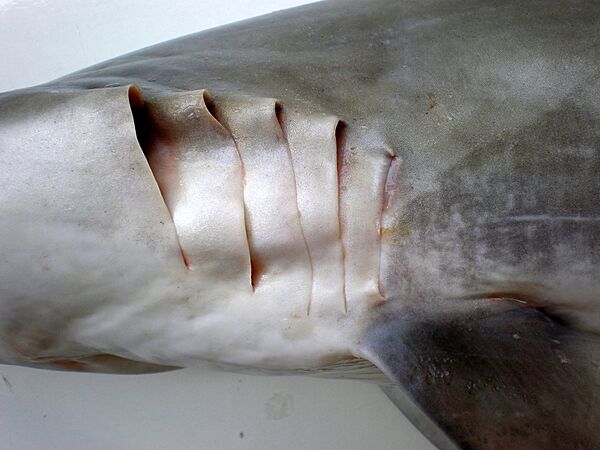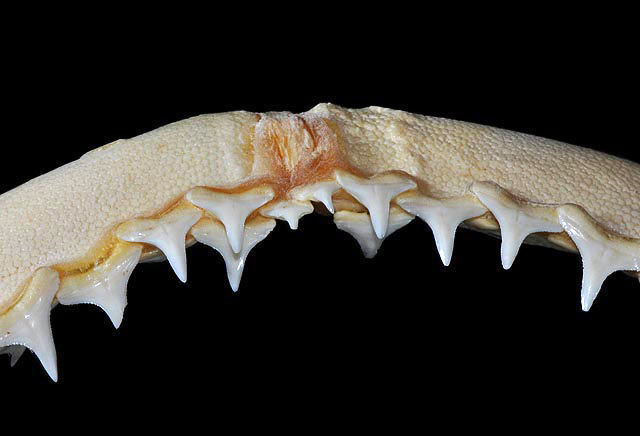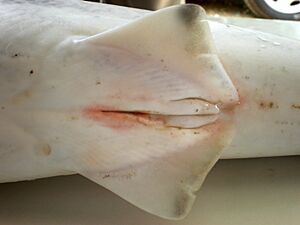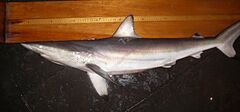Spinner shark facts for kids
Quick facts for kids Carcharhinus brevipinna |
|
|---|---|
 |
|
| Conservation status | |
| Scientific classification | |
| Genus: |
Carcharhinus
|
| Species: |
brevipinna
|
 |
|
| Range of the spinner shark | |
| Synonyms | |
|
Aprionodon caparti Poll, 1951 |
|
The spinner shark (Carcharhinus brevipinna) is a type of requiem shark. It belongs to the Carcharhinidae family. This shark gets its name from its amazing feeding trick. It spins and leaps out of the water while hunting!
You can find spinner sharks in warm waters all over the world. They live in tropical and warm temperate oceans. However, they are not found in the eastern Pacific Ocean. These sharks prefer shallow waters, but can dive up to 100 m (330 ft) deep.
Spinner sharks look a lot like a bigger version of the blacktip shark. They have a slim body and a long snout. Their fins often have black tips. You can tell a spinner shark apart by its first dorsal fin. It has a different shape and is placed further back. Also, adult spinner sharks have a black tip on their anal fin. These sharks can grow up to 3 m (9.8 ft) long.
Spinner sharks are fast and social predators. They eat many kinds of small bony fishes and cephalopods like squid. When they hunt schools of fish, they swim straight up through the school. They spin around with their mouths open, catching fish. This spinning motion often makes them jump out of the water!
Like other sharks in their family, spinner sharks give birth to live young. Females have three to 20 pups every two years. The young are born in shallow areas near the coast. They grow quite fast. Spinner sharks are usually not dangerous to humans. But they can get excited if there's a lot of food around. People catch spinner sharks for their meat, fins, and liver oil. They are also popular with recreational fishers because they are strong fighters. The International Union for Conservation of Nature (IUCN) says the spinner shark is a Vulnerable species. This means their numbers are decreasing.
Contents
What's in a Name?
The spinner shark was first described in 1839. Two scientists, Johannes Peter Müller and Friedrich Gustav Jakob Henle, gave it the name Carcharias (Aprion) brevipinna. They studied a shark skin from Java. Over time, this shark was placed in different groups. Finally, it was put into the Carcharhinus group.
The shape of its teeth and its colors can change a lot. This depends on the shark's age and where it lives. This made it confusing for scientists to identify it. Spinner sharks have many other common names. These include black-tipped shark, great blacktip shark, and long-nose grey shark.
Scientists once thought the spinner shark was closely related to the blacktip shark. This was because they looked similar and behaved alike. But later studies showed this wasn't true. These similarities are just a coincidence. A study in 1992 suggested the copper shark is its closest relative. Another study in 2007 found that the spinner shark is quite unique. It's not as closely related to other Carcharhinus species as some other sharks.
Where Do Spinner Sharks Live?
Sometimes, it's hard to tell spinner sharks apart from blacktip sharks. This makes it tricky to know their exact numbers in some areas. In the western Atlantic Ocean, they live from North Carolina to the northern Gulf of Mexico. This includes the Bahamas and Cuba. They are also found from southern Brazil to Argentina.
In the eastern Atlantic, they live off North Africa to Namibia. In the Indian Ocean, you can find them from South Africa and Madagascar. They also live in the Red Sea, the Gulf of Aden, India, and nearby islands. They are found near Java and Sumatra. In the Pacific Ocean, they live off Japan, Vietnam, and Australia. Some might also be in the Philippines. Scientists think some Indian Ocean spinner sharks have traveled through the Suez Canal. They have moved into the Mediterranean Sea.
Spinner sharks have been seen from the ocean surface down to 100 m (330 ft) deep. But they really like water that is less than 30 m (98 ft) deep. They can be found near the coast or far out at sea. Young spinner sharks sometimes go into bays. But they avoid water that is too salty or not salty enough.
Sharks in the northwest Atlantic move around a lot. In spring and summer, they stay in warm, shallow waters. In winter, they travel south to deeper waters.
What Do Spinner Sharks Look Like?
An average spinner shark is about 2 m (6.6 ft) long. It weighs around 56 kg (123 lb). The biggest spinner shark ever found was 3 m (9.8 ft) long and weighed 90 kg (200 lb). Sharks from the Indo-Pacific region are usually larger than those from the northwest Atlantic.
This shark has a sleek, smooth body. It has a long, pointed snout. Its eyes are small and round. There are clear grooves at the corners of its mouth. Spinner sharks have many rows of teeth. The upper jaw has 15 to 18 rows on each side. The lower jaw has 14 to 17 rows on each side. Their teeth are long and narrow. They are finely serrated (like a saw) in the upper jaw. The lower jaw teeth are smooth. They have five long pairs of gill slits.
The first dorsal fin is fairly small. It usually starts behind the tips of the pectoral fins. There is no ridge between the first and second dorsal fins. The pectoral fins are short, narrow, and curved like a sickle. The shark's skin is covered in tiny, diamond-shaped scales called dermal denticles. These have small ridges.
Spinner sharks are gray on top, sometimes with a bronze shine. Their underside is white. There's a faint white band on their sides. Young sharks have plain fins. But older sharks have black tips on their second dorsal fin, pectoral fins, anal fin, and lower tail fin. Sometimes other fins have black tips too.
Spinner sharks are different from blacktip sharks. Their first dorsal fin is a bit more triangular. It's also placed further back on their body. Adult spinner sharks also have a black tip on their anal fin, which blacktip sharks usually don't.
Life and Habits
The spinner shark is a fast and active swimmer. They sometimes form large schools. These schools are often separated by age and sex. Young sharks prefer cooler water than adults. Off South Africa, female spinner sharks stay close to shore all year. Males only appear there during the summer.
Smaller spinner sharks can be eaten by larger sharks. Spinner sharks can have tiny creatures called parasites living on them. These include copepods that live on their gills or skin.
What Do They Eat?
Spinner sharks mainly eat small bony fish. This includes sardines, herring, anchovies, mullets, and tunas. They also eat stingrays, cuttlefish, squid, and octopus. Groups of spinner sharks often chase schools of prey very fast.
They swallow individual prey whole. Their teeth are not made for cutting. Spinner sharks have a special way of hunting small fish schools. They charge straight up through the school. They spin on their body axis with their mouth open. This helps them snap up fish all around them. The shark's speed often makes it jump out of the water at the end. This is how it got its name! Blacktip sharks also do this, but not as often.
Off Madagascar, spinner sharks follow migrating schools of mackerel and tunas. Like blacktip sharks, they gather around shrimp trawlers. They eat the fish that are accidentally caught and thrown back. This can sometimes cause a feeding frenzy.
Reproduction and Life Cycle
Like other requiem sharks, spinner sharks give birth to live young. Female sharks have one working ovary and two working uteri. Each uterus has sections for each embryo. The embryos first get food from a yolk sac. When an embryo grows to about 19 cm (7.5 in) long, the yolk runs out. Then, the empty yolk sac becomes a placenta. This connection lets the mother give nutrients to the baby shark.
Females usually give birth to three to 20 pups. Most often, they have seven to 11 pups. They do this every two years. Pregnancy lasts for 11 to 15 months. Mating happens from early spring to summer. Pups are born in August off North Africa. They are born from April to May off South Africa. In the northwestern Atlantic, they are born from March to April. Young sharks are born in coastal nursery areas. These are places like bays and beaches.
Baby spinner sharks are born about 60 cm (24 in) to 77 cm (30 in) long. They grow quite fast. Newborns grow about 30 cm (12 in) per year. One-year-olds grow about 25 cm (9.8 in) per year. Teenagers grow about 10 cm (3.9 in) per year. Adults grow about 5 cm (2.0 in) per year.
In the northwestern Atlantic, males become adults when they are about 1.3 m (4.3 ft) long. This is when they are 4 to 5 years old. Females become adults when they are about 1.5–1.6 m (4.9–5.2 ft) long. This is when they are 7 to 8 years old. Off South Africa, males become adults at 1.8 m (5.9 ft). Females become adults at 2.1 m (6.9 ft). Spinner sharks usually don't have babies until they are 12 to 14 years old. They can live for 15 to 20 years or even longer.
Spinner Sharks and Humans
Spinner sharks are usually not dangerous to people. They don't see large mammals as food. Their small, narrow teeth are made for grabbing, not cutting. However, they can get very excited if there's food nearby. So, be careful if you see one while spearfishing. As of 2008, there were 16 unprovoked attacks by spinner sharks reported. None of these attacks were deadly.
Spinner shark meat is good quality. It is sold fresh or dried and salted. Their fins are used for shark fin soup in East Asia. Their liver oil is used for vitamins. Their skin can be made into leather products. Spinner sharks are an important catch for fishing boats in the northwestern Atlantic and Gulf of Mexico. In the United States, their meat is often sold as "blacktip shark" meat. This is because blacktip shark meat is thought to be better. It's likely that other countries also catch spinner sharks. But these catches might not be reported because they are confused with blacktip sharks.
Spinner sharks are also very popular with people who fish for fun. They are known as "spectacular fighters" because they often leap out of the water.
The IUCN has listed the spinner shark as Vulnerable worldwide. This means their population is at risk. They often live near the coast, which makes them more likely to be caught by humans. It also makes them vulnerable to changes in their habitat. The US government manages the fishing of this species. They have rules for how many can be caught by commercial and recreational fishers.








